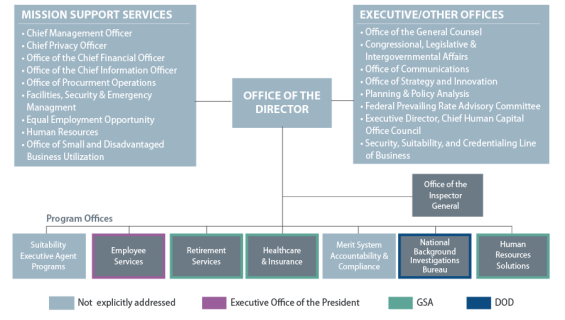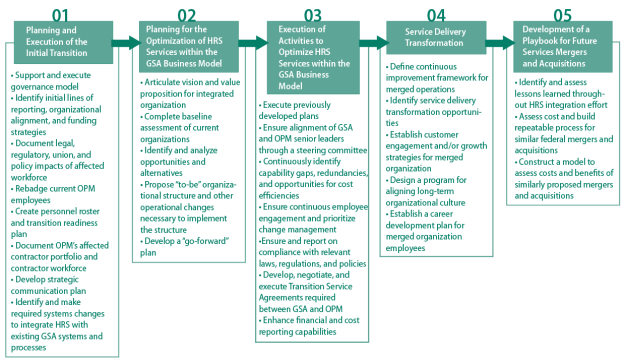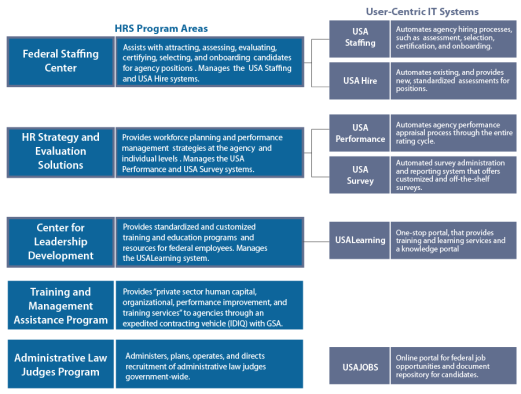GSA Releases Sources Sought Notice and Sets Goal to Assume Certain OPM Functions by March 2019
On June 21, 2018, the Trump Administration released a government reorganization and reform plan that included 32 proposals to restructure and reform executive branch agencies, programs, or operations. One proposal sought to reorganize the U.S. Office of Personnel Management (OPM), particularly by transferring five program offices to other agencies (Figure 1). Under the proposal, functions of three program offices would be transferred to a "Government Services Administration" (currently the General Services Administration, or GSA)
|
Figure 1. OPM Organizational Structure Current Structure and Proposed Reorganization |
 |
|
Source: Adapted from U.S. Office of Personnel Management, FY2019 Congressional Budget Justification and Annual Performance Plan, February 2018, p. 28, https://www.opm.gov/about-us/budget-performance/budgets/congressional-budget-justification-fy2019.pdf. |
The OPM director and GSA administrator announced their plans to proceed with the proposed transfer of HRS, HI, and RS to GSA during a hearing held by the Senate Committee on Homeland Security and Governmental Affairs on July 26, 2018. The agencies intend to implement the transfers using a phased approach, with the first phase focusing on integrating HRS functions into GSA. They established separate task forces to support the proposed transfers, which are reportedly creating implementation plans and timelines for the HRS transition.
Anticipated Contractor Support for OPM/GSA Transition
GSA anticipates using a contractor to facilitate the transfer of HRS, HI, and RS functions to GSA. To that end, GSA released a sources sought notice on August 7, 2018, which is integral to the advisory multi-step process the agency is using for the procurement. Contractor responses were due August 17, 2018.
Sources Sought Notice
The primary objective of the sources sought notice is for GSA to obtain information that it can use to develop and finalize its procurement strategy. Relatedly, prospective contractors' responses to the notice will help GSA in identifying those contractors capable of meeting the objectives described in the notice. The notice is not a solicitation. GSA tentatively plans to release a solicitation during the fourth quarter of FY2018 and intends to award a fixed price or labor-hour type contract. The anticipated period of performance includes a 12-month base period and two 12-month option periods (i.e., September 30, 2018 to September 30, 2021).
Planned Scope of Work
GSA anticipates the need for contractor support to transfer HRS, HI, and RS to GSA, although initial efforts would focus on the HRS transition. Serving as an extension of the OPM/GSA task force, the contractor would "provide strategic planning, consulting, and program management support services to transition and integrate HRS's organization and offerings" into GSA. The contractor's scope of work would include achievement of five core objectives, the first of which would be to complete an initial transition of HRS to GSA by March 30, 2019 (Figure 2).
 |
|
Source: CRS analysis of U.S. General Services Administration, "HRS Integration Support," ID05180049, Sources Sought Notice, August 7, 2018, https://www.fbo.gov/index.php?s=opportunity&mode=form&id=67619ed433ff070c6d339253e1b8a3cf&tab=core&tabmode=list&=. |
Background on OPM HRS Structure and Functions
HRS provides products and services that aim to help agencies perform core HR functions, such as recruitment and retention, performance management, strategic workforce planning, and training. HRS offers these resources to agencies on a reimbursable basis directly or through commercial providers. HRS is financed by OPM's revolving fund, which requires setting the price of products and services to recover all operational costs. HRS's costing methodologies and pricing structures vary by service.
HRS consists of five program areas, each of which provides agencies with resources to fulfill different core HR functions (Figure 3). HRS and GSA partner to provide certain services. For example, the HRS Training and Management Assistance Program partnered with GSA to create the Human Capital and Training Solutions contracts, a procurement vehicle that provides training and development, human capital strategy, and organizational performance services to agencies. HRS employs six primary user-centric information technology (IT) systems that automate a wide range of HR functions and processes for agencies (Figure 3). For example, USA Staffing allows agencies to automate key steps in the federal hiring process, such as generating job opportunity announcements via USAJOBS and rating and ranking applicants.
 |
|
Source: CRS analysis of U.S. Office of Personnel Management, FY2019 Congressional Budget Justification, February 2018, pp. 120-128, https://www.opm.gov/about-us/budget-performance/budgets/congressional-budget-justification-fy2019.pdf. Notes: According to the Justification, the USAJOBS program management office was "realigned" from the Office of the Chief Information Officer to HRS in October 2017. It is unclear where the program management office is located within HRS's organizational structure. |
Congressional Oversight
Congress may monitor ongoing efforts to transfer HRS functions to GSA, such as the
- implementation of the initial transition of HRS to GSA, including an assessment of the project plans and timelines produced by the OPM/GSA task force and more detailed information on the anticipated role of a contractor;
- projected costs to transition HRS to GSA, including costs associated with soliciting and using contractors; and
- structure and functions of the OPM/GSA task force, including membership, coordination (i.e., two separate task forces or one joint task force), and the specific activities being undertaken.
Congress may also consider broader policy issues, such as the
- specific HRS program areas, IT systems, and functions to be transferred and how they will be integrated into GSA's existing organizational structure;
- specific statutory changes needed, if any, to transfer HRS functions into GSA and any subsequent impact on meeting the initial transition deadline of March 30, 2019;
- impact on the structure and functions of remaining OPM program, mission support, and executive offices;
- impact on the overall effectiveness of HRS's operations;
- impact on OPM and GSA staffing and funding, such as the elimination of positions or redirection of funding to certain HRS programs and activities;
- whether GSA possesses the capacity, resources, and expertise necessary to undertake HRS functions (and strategies to mitigate any shortfalls);
- strategies employed by GSA and OPM to balance cost efficiency and mission effectiveness and identification of any associated tradeoffs; and
- extent to which the HRS transition aligns with congressional priorities regarding federal human capital and personnel reform.